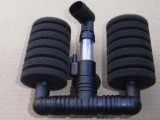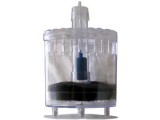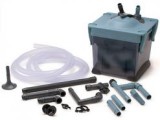Different Types Of Aquarium Filters

There are various filtration methods that can be used to keep the water in your aquarium suitable for your fish.
Beneath are the most common types that you will find.Before you start reading this section be sure that you have read and understood the articles about Aquarium Filtration and Water Chemistry in Keeping Aquatics The Basics. This is important as it will make it easier to understand how the equipment is actually working.

Sponge Filter
Sponge filters are generally simple and inexpensive to buy. With a little bit of effort it is also fairly easy to make your own.Although there are a variety of designs, sponge filters all work on the same basic principle. Water is pulled through the sponge, via a pump and bacteria living in the sponge change the nitrite into nitrate.
Although, sponge filters are generally not considered the best form of filtration. they can be very useful. Both as a secondary system and also in breeding tanks as there is no risk of the fry being damaged by the air-intake.
If a sponge filter is kept in an aquarium with another filtration system, in an emergency it can be simply removed and used as a biological filter. As the sponge will already have its own colony of bacteria, it will not need the normal time to reach peak efficiency.

Corner Filter
The corner filter works in a similar manner to the sponge filter and in the past was the most popular filtration system.The filter works on the principle of air lift. The bubbles produced by a pump push the water up the tube this means that water then flows through the filter. The corner filter is very inexpensive and comes in two different types: with or without an airstone. The air stone creates much smaller bubbles meaning that the water is not so agitated.

Power Filter
Power filters are now the most popular aquarium filtration system and there are many different models and varieties to choose from.The power filter works by drawing water from the aquarium, through the filtration medium before returning it to the tank. Power filters can combine both mechanical and biological filtration systems. The filtration mediums used include sponge and disposable cartridges.
Some power filters are mounted inside the tank, whilst others are external and often referred to as 'Hang On The Back Filters'.

Canister Filter
Canister filters are very similar to power filters. They are generally quite expensive and reside outside of the aquarium.They are large and so can provide a high volume of filter material. As they reside outside of the tank they can be cleaned without disturbing the fish. The disadvantages apart from cost is that they are comparatively complex and are primarily a mechanical filter.

Undergravel Filter
Undergravel filters have been in the hobby for many years. They work on a similar principle to the sponge and corner filter, by using air to circulate water through the filter medium.In the case of the undergravel filter, the base of the aquarium acts as the filter. Air traveling up the pipe draws water down through the substrate (normally gravel) where biological filtration takes place and then under the base plate.
The system is normally used for freshwater aquariums, but is generally not recommended if you are planning to plant the aquarium.
A more recent development has been the reverse-flow undergravel filter. A power filter is used to push water down the tube and then up through the plate and substrate. This means there is less chance of debris building up within the substrate.